National Museum of African American History and Culture prepares to open in Washington, DC
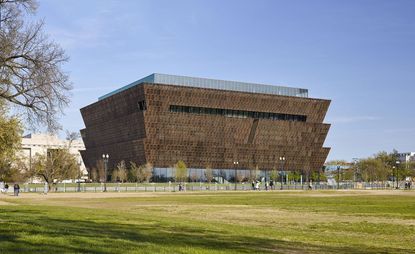
In advance of its official opening on 24 September, the National Museum of African American History and Culture (NMAAHC) in Washington, DC, held a special preview day for the press on 14 September. For most of the several hundred attendees, it was the first chance to look inside the 400,000-sq-ft building, designed by a consortium of firms helmed by David Adjaye and Philip Freelon.
Fulfilling an idea that dates back to the early 1900s, but has met political opposition along the way, the museum honors the achievements of African Americans while telling the 'unvarnished truth', in the phrasing of one curator, about their oppression. The new museum was given the last buildable spot on the National Mall, Washington’s monumental core.
At the preview, David Skorton, secretary of the Smithsonian, and Lonnie Bunch, the museum’s director, addressed a full-to-capacity house in the Oprah Winfrey Theater (the TV personality was a major donor). 'We felt it was crucial to craft a museum that would help America remember and confront its tortured racial past,' Bunch said. 'But, it also had to find the joy, the hope, the resiliency, the spirituality, that was embedded in this community. The goal was to find that tension.'
That tension plays out in the sequence of galleries. They begin underground, telling the story of slavery and struggle in dark, compressed spaces, and through exhibits such as a slave auction block, a slave cabin from South Carolina, and a shawl and hymnal that belonged to abolitionist Harriet Tubman. Switchbacking ramps and a twisting black staircase lead up to the building’s main lobby. Above this rise two more gallery levels celebrating African American culture and institutions. Here, visitors can see Chuck Berry’s cherry-red Cadillac and Muhammad Ali’s boxing gear, or explore work by black visual artists.
Wrapping the upper levels is the filigreed 'corona', the signature design element of the museum, its form inspired by the tiered crowns found in Yoruban sculpture. The corona is composed of more than 3,000 aluminum panels with a PVDF coating, and it received close attention from the architects, as well as Washington’s powerful design-review boards.
'I was obsessed with this detail,' Adjaye says. '[The coating] is the same luminosity as bronze. It reflects and absorbs light exactly the way bronze does.' On the highly symbolic national landscape of the Mall, Adjaye says, there was no option but to get it just right. 'There was an understanding that this was in the nation’s capital, it was going to be looked at by everyone and it had to be perfect.'
President Obama (who gets his own exhibit case inside) will make a dedication to the museum on the opening weekend, and The Roots and other acts will play at a free music festival. Public interest is high: passes were snapped up so quickly that the museum extended its hours and issued more. Clearly, says Freelon, 'there was a pent-up demand for this sort of cultural institution on a national scale'.

Wrapping the upper levels is a filigreed ’corona’, the signature design element of the museum, its form inspired by the tiered crowns found in Yoruban sculpture
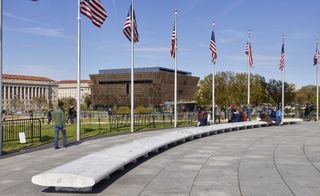
The new museum was given the last buildable spot on the National Mall, Washington’s monumental core

Fulfilling an idea that dates back to the early 1900s, the museum honors the achievements of African Americans while telling the ’unvarnished truth’, in the phrasing of one curator, about their oppression

The remit of the museum was to ’help America remember and confront its tortured racial past,’ said Smithsonian director Lonnie Bunch.

Switchbacking ramps and a twisting black staircase lead up to the building’s main lobby

Above this rise two more gallery levels celebrating African American culture and institutions

On the highly symbolic national landscape of the Mall, Adjaye says, there was no option but to get it just right. ’There was an understanding that this was in the nation’s capital, it was going to be looked at by everyone and it had to be perfect’
INFORMATION
For more information, visit David Adjaye’s website
Photography: Alan Karchmer
Wallpaper* Newsletter
Receive our daily digest of inspiration, escapism and design stories from around the world direct to your inbox.
-
 ‘There are hidden things out there, we just need to look’: Studiomama's stone animals have quirky charm
‘There are hidden things out there, we just need to look’: Studiomama's stone animals have quirky charmStudiomama founder's Nina Tolstrup and Jack Mama sieve the sands of Kent hunting down playful animal shaped stones for their latest collection
By Ali Morris Published
-
 Tokyo firm Built By Legends gives fresh life to a performance icon, Nissan’s R34 GT-R
Tokyo firm Built By Legends gives fresh life to a performance icon, Nissan’s R34 GT-RThis Japanese restomod brings upgrades and enhancements to the Nissan R34 GT-R, ensuring the cult of the Skyline stays forever renewed
By Jonathan Bell Published
-
 Squire & Partners' radical restructure: 'There are a lot of different ways up the firm to partnership'
Squire & Partners' radical restructure: 'There are a lot of different ways up the firm to partnership'Squire & Partners announces a radical restructure; we talk to the late founder Michael Squire's son, senior partner Henry Squire, about the practice's new senior leadership group, its next steps and how architecture can move on from 'single leader culture'
By Ellie Stathaki Published
-
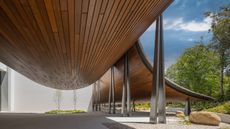 Gulbenkian Foundation's new art centre by Kengo Kuma is light and inviting
Gulbenkian Foundation's new art centre by Kengo Kuma is light and invitingLisbon's Gulbenkian Foundation reveals its redesign and new contemporary art museum, Centro de Arte Moderna (CAM), by Kengo Kuma with landscape architects VDLA
By Amah-Rose Mcknight Abrams Published
-
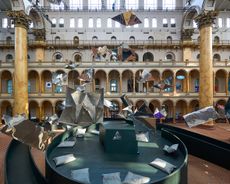 ‘Reflective fractals’ by Suchi Reddy take over the National Building Museum in Washington
‘Reflective fractals’ by Suchi Reddy take over the National Building Museum in WashingtonReddymade founder Suchi Reddy’s reflective installation ‘Look Here’ launches at the National Building Museum in Washington
By Ellie Stathaki Published
-
 130 William by Adjaye Associates’ holistic vision is unveiled in New York
130 William by Adjaye Associates’ holistic vision is unveiled in New YorkWe unveil the holistic design of Adjaye Associates’ 130 William, the residential scheme that has just completed in New York
By Ellie Stathaki Published
-
 National Portrait Gallery reopens its refreshed home
National Portrait Gallery reopens its refreshed homeLondon’s National Portrait Gallery reopens with a design by leading architect Jamie Fobert and conservation specialist Purcell
By Ellie Stathaki Published
-
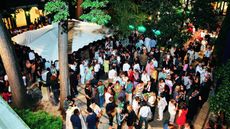 Venice Architecture Biennale 2023: the ultimate guide
Venice Architecture Biennale 2023: the ultimate guideAs the Venice Architecture Biennale 2023 opens, we explore the offerings at the world’s famous celebration of building design
By Ellie Stathaki Last updated
-
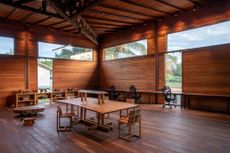 The Museum of Amazonian Science offers global hope and sustainability
The Museum of Amazonian Science offers global hope and sustainabilityAn environmentalist’s ambitious project includes the Museum of Amazonian Science in Brazil and fulfils his vision of powering up the local bioeconomy and saving humanity
By Scott Mitchem Published
-
 Sydney Modern opens its doors and reveals immersive SANAA architecture
Sydney Modern opens its doors and reveals immersive SANAA architectureSANAA’s Sydney Modern opens its doors to the public in Australia
By Ellie Stathaki Published
-
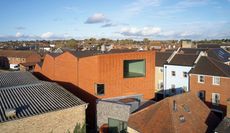 Refreshed Gainsborough House in Suffolk gears up for reopening
Refreshed Gainsborough House in Suffolk gears up for reopeningThomas Gainsborough House in Suffolk reopens to a design by architecture studio ZMMA
By Ellie Stathaki Published